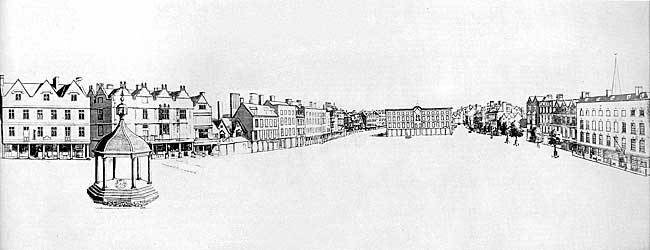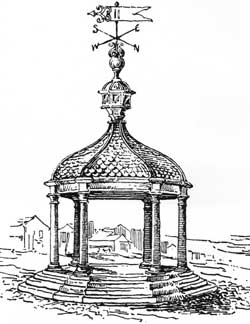< Previous | Contents | Next >

The Market Place as depicted by Thomas Sandby, c.1740.
In 1654 John Evelyn, in the course of an extended tour through England, visited Nottingham, and he describes it as possessing "an ample Market Place with an open sough and pond in the centre, a mouldering stone wall down its midst, trees, saw-pits, stocks, pillory and ducking stool." This description is extremely interesting and illuminating, presenting to us the picture of a typical open country market such as may even to-day be found in certain small out-of-the-way towns of our country, and before we consider the Market Place in detail let us try to elaborate Evelyn's description. We know that the slope from Long Row to South Parade was broken by a bank and that the sandy soil near this bank was spoken of as "The Sands," and was used as a horse market for the soft soil would be excellent for trying horses. The horse pond which Evelyn mentions disappeared at an early date, but it would be very convenient for ducking scolds by means of a ducking stool if for nothing else. The sough or drain in front of the Long Row was not filled in until 1826 and the soil for filling this hole was fetched all the way from the top of Mansfield Road near St. Andrew's Church.
There was a row of seven elm trees which stretched across the market parallel to South Parade, which were rather famous because of their handsome appearance. Against them was stored the great baulks of timber and the planks that were brought to Nottingham Market Place for sale, and consequently South Parade got its ancient name of Timber Hill. These trees, whose shade must have been very grateful, remained until 1791 in which year they were felled. Of the saw-pits mentioned by Evelyn, I can only find mention of one and that was excavated just at the end of Peck Lane. It must have been a terrible danger for it would be left open, day and night, and one must remember that until the 17th century there was no attempt at lighting the town after dark. Of stocks the town had five sets, one of them stood in front of the Exchange opposite Exchange Walk and close to it was the pillory. When this ghastly instrument was first erected I cannot say, but in 1808 it was found to be worn out and a new one was erected on its site, but this new one did not remain long in use for the last public exposure in pillory was that of a Scotchman called Calvin who suffered in 1808. The ducking-stool was kept on the Poultry which from 1332 to 1799 was spoken of as Cuckstool Row because of this ducking- or cucking-stool. What this unpleasant instrument looked like one can readily see by considering the one that is still preserved in the church at Leominster. It was a sort of see-saw at one end of which was fixed a chair into which the wretched victim was firmly fastened. She was let down into the water, presumably the horse pond in the middle of the market, again and again until she was so exhausted that sometimes she died from the effects. The punishment was really very severe and probably had quite as good an effect on curbing the tongues of voluble ladies as had the crank or scold's bridle which was used more generally. We have seen that we have a relic of this cucking-stool in the name of Poynton Street which was named after Widow Poynton, who in 1609 was ducked as a scold.
The whole of this great area was in its natural state for the greater part of its existence, it would be horribly muddy in winter and dusty in summer, and eventually it got into so unpleasant a condition that in 1720 it was paved with boulders which had an interesting history, for they were fetched from the Fosse Way in the neighbourhood of Willoughby-on-the-Wolds and had begun life as the pavement of that great Roman thoroughfare. To pay the expense of this paving it was decided to levy a tax upon all corn produced for sale in the market, which tax was much resented by the farmers who got round it with difficulty by bringing samples of their corn and not the corn itself, and of course the samples were not taxed. Eventually the whole market was levelled and its surface smoothed over, a decent pavement put down and Long Row flagged in 1826. This was the first pavement in Nottingham to be flagged. Heretofore the pavements had been made of cobbles just as they remain to-day in some of the less important streets of Loughborough and other towns.
In addition to the many objects which we have already considered in the Market it was beautified by three crosses. The first was the Hen Cross which stood in the Poultry and round which was the women's market, where goods of feminine interest were disposed of. It is first mentioned in 1416 and what its early appearance was I cannot say. By the 18th century it was a column standing on four steps and was surmounted by a ball and was by no means an object of beauty. It was cleared away in 1801 and the stones were used to repair Trent Bridge. The Butter Cross which probably stood near the top of Exchange Walk is first mentioned in 1572, but there is a Cheese Cross mentioned in 1543 and this probably is the same as the Butter Cross. Unfortunately we have no knowledge of what the Butter Cross looked like and there are few references to it to be found. It was all cleared away in 1700.
 The Malt Cross.
The Malt Cross.The most important cross was the Malt Cross which stood about where Queen Victoria's statue now stands and which was first mentioned in 1495. It was the corn market for the whole neighbourhood and really seemed to have been the Market Cross of Nottingham. In its early days it stood upon ten steps and was born aloft by a long shaft, but in 1711 this early cross was replaced by a roofed structure surmounted by sundials carried on six columns which stood upon a base raised four steps above the common market place. It was pulled down in 1804. From this cross, upon occasion, Royal proclamations and other public notices were given and round it gradually concentrated the earthenware and crockery trade of the market.
There were wells in the market and some of these were fitted with pumps. For example the pump outside the Exchange is mentioned in 1794, and right away down till 1870 pumps remained outside the Exchange and on Beastmarket Hill.
There was a bull ring in the market in 1750, but I am not sure where it was, I rather think opposite St. James's Street. In those days it was the custom for the Mayoress to provide the rope by which the bulls which were to be baited were attached to the ring, in return for which service each burgess who took up his freedom during her husband's year of office paid 1/- pin money to the Mayoress.
The sheep and cattle pens remained along Beastmarket Hill until about 1870 in which year they were moved to where the Guildhall now stands.
A good many interesting events have taken place in this market place, even if we refrain from going into the details of the old election riots. In 1485 Richard III. reviewed his army either in Nottingham Meadows or more probably in Nottingham Market Place before his departure to his defeat and death at Bosworth. In 1688 an event of the greatest importance occurred at the Malt Cross. Public feeling had been settling against James II. and his policy and at last it had come to a head. The Duke of Devonshire was the great leader in this neighbourhood and after a conference with the leading gentry of the Midlands, which had taken place probably in what is now the Oriental Cafe in Wheeler Gate, the Duke accompanied by Lord Delamere, Sir Scroop Howe, Mr. Hutchinson and others proceeded to the Malt Cross where they read a declaration that they had decided to throw in their lot with William, Prince of Orange. The market folk gladly followed their lead and as far as the Midlands were concerned James's cause was lost.
